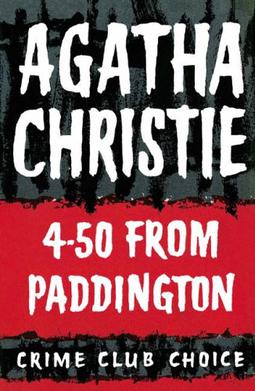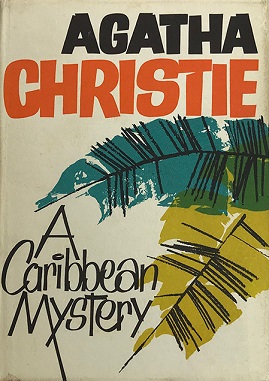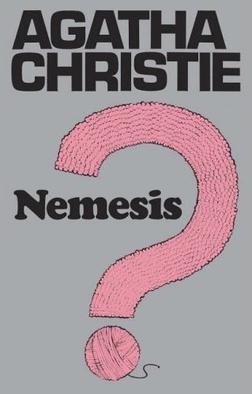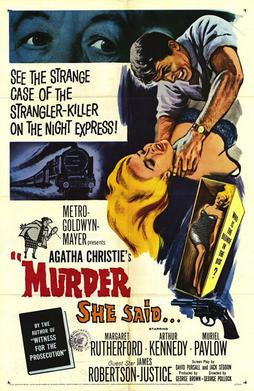Plot summary - spoilers
Upon his return to England after his overseas job in the police, Luke Fitzwilliam shares a London-bound train carriage with Lavinia Pinkerton. She talks to him about her reason for travelling to Scotland Yard: she plans to report a serial killer in her village and tells him who was killed and who will next be killed – Amy Gibbs, Tommy Pierce, and Harry Carter have been killed; Dr John Humbleby will be the next victim. This woman reminds him of a favourite aunt, so he replies politely and recalls what she said.
Luke reads of Miss Pinkerton's death the next day, and then of the death of Dr Humbleby, who has died of septicaemia. Luke will not let this rest, and he travels to the village, Wychwood under Ashe. He poses as one finding material for a book on beliefs in witchcraft and superstition, as he investigates. He stays at the home of Gordon Ragg aka Lord Whitfield (Easterfield in the U.S. edition), claiming to be a cousin of Bridget Conway, Whitfield's fiancée, who is the cousin of his own good friend. He and Conway receive the assistance of Honoria Waynflete, a woman who, they believe, may know the person behind the deaths. He talks with villagers to learn the stories of the recent murders, including Mr Abbot, the solicitor who fired Tommy Pierce from his service; the Reverend Mr Wake, local rector; Mr Ellsworthy, an antique shop owner who appears to be mentally unstable; and Dr Thomas, Humbleby's younger partner. People in the village view the deaths as accidents. Amy Gibbs died after confusing her cough remedy with hat paint in the dark, Tommy Pierce died from falling from an upper-floor window at the library while cleaning the windows, Harry Carter fell from a bridge while drunk and drowned in the mud, and Humbleby died from a cut that became infected. Luke learns that Mrs Lydia Horton was another victim of these accidents – she was recovering from acute gastritis and was getting better before she had a sudden relapse and died.
Luke believes Ellsworthy to be the killer because of his mental instability. Seeing Ellsworthy return home with blood on his hands adds to this image. Later on in that day, Luke and Miss Waynflete witness Whitfield arguing with his chauffeur, Rivers, who had taken Whitfield's Rolls-Royce for a joyride. Luke finds Rivers dead, hit by a decorative stone. Luke and Bridget realise that they are in love with each other, and Bridget tells Gordon of her decision to break off her engagement with him. Speaking to Luke, Gordon makes an odd statement. He claims that God kills people that do him harm, dispensing divine justice upon wrongdoers. Whitfield mentions that Mrs Horton had argued with him, Tommy Pierce did mocking impressions of him, Harry Carter shouted at him while drunk, Amy Gibbs was impertinent to him, Humbleby disagreed with him on the village water supply, and Rivers used his car without permission and then spoke disrespectfully to him; and all of them died soon afterwards. Whitfield predicts that Luke and Bridget, having wronged him, will soon meet their fates too.
Luke changes his mind about who is responsible for the deaths, considering Whitfield as the murderer. He consults Miss Waynflete, who confirms his suspicions, and tells him of how she knew he was insane: when they were younger, Waynflete and Whitfield had been engaged to be married. But one evening, Whitfield killed the bird that she kept as a pet, with the appearance that he enjoyed doing it, and she says she ended their engagement.
Luke and Bridget decide that Bridget will leave Whitfield's estate to stay at Honoria Waynflete's house. Luke collects their luggage and prepares to leave, while Bridget and Honoria take a walk in the woods. Honoria reveals herself to be the murderer. During her engagement to Whitfield, Honoria had killed her own pet bird after it bit her, which prompted Gordon to abandon the engagement. She vowed revenge on Gordon, and decided to set him up for crimes he did not commit. She encouraged him in the belief that God exacted immediate retribution from those who disrespected him.
Honoria had poisoned the tea for Lydia Horton, while encouraging others to believe the problem was in the grapes sent by Whitfield. Honoria killed Amy by swapping the bottles around in the night and locking the door from the outside using pincers. She killed Carter by pushing him off the bridge on the day he had a row with Whitfield, and she likewise pushed Tommy Pierce out of the window while he was working. Whitfield had been the one to assign Tommy to this job.
Honoria had seen that Lavinia Pinkerton realised she was the killer and that Humbleby would be her next victim. Honoria had followed Lavinia into London and then pushed her in front of a passing car. Honoria framed Whitfield by telling a witness that she saw the registration number of Whitfield's Rolls-Royce. After inviting Humbleby round to her house, she cut his hand with scissors. She then applied a dressing to the wound, a dressing with pus seeping from her cat's ear; Humbleby dies a few days later from blood infection. After witnessing Rivers being sacked, Honoria hits him with a sandbag and caves his skull in with the stone pineapple.
Honoria drugs Bridget's tea and takes her into the woods, where the two of them begin talking. Bridget has not drunk the tea (though Honoria doesn't know that) and is ready for what comes. Honoria reveals a knife covered in Whitfield's fingerprints, and informs Bridget that she will kill her and leave the knife at the scene. Further, Honoria arranges for Whitfield to be seen walking alone through the area where Bridget's body will be. Instead, Bridget fights with Honoria. Luke realises that Honoria is the murderer and rescues Bridget. Bridget and Luke leave the village to live together as a married couple.
Literary significance and reception
The Times Literary Supplement of 10 June 1939 published a review of the book by Maurice Percy Ashley, together with And Death Came Too by Richard Hull which began "A week in which new novels by Mr Hull and Mrs Christie appear should be a red letter week for connoisseurs of detective fiction. One must, however, reluctantly confess that neither of them is fully up to standard."
After considering in isolation And Death Came Too, Ashley turned his attention to Murder Is Easy and started, "Mrs Christie has abandoned M. Hercule Poirot in her new novel, but it must be confessed that his understudy, Luke Fitzwilliam, a retired policeman from the Mayang States is singularly lacking in 'little grey matter.' Poirot may have recently become, with advancing years, a trifle staid, but absence makes the heart grow fonder of him." After outlining the basics of the plot and the romantic interests of the main character, Mr Ashley concluded, "He (Luke) is less effective a detective than as a lover, which is not surprising since neither he nor the reader is provided with any clear clues pointing to the fantastically successful murderer. The love interest scarcely compensates for the paucity of detection and the characters verge on caricature; nor is Fitzwilliam able to recapture vividly enough the circumstances of the earlier murders." [4]
In The New York Times Book Review for 24 September 1939, Kay Irvin said the book was "one of Agatha Christie's best mystery novels, a story fascinating in its plot, clever and lively in its characters and brilliant in its technique." She concluded, "The story's interest is unflagging, and the end brings excitement as well as surprise." [5]
William Blunt in The Observer of 4 June 1939 raised a question regarding Christie's abilities to write non-crime fiction, which demonstrates that her pen name identity of Mary Westmacott was not yet public knowledge: "I should hate to have to state on oath which I thought was Agatha Christie's best story, but I do think I can say that this is well up in the first six. The humour and humanity of its detail raise a question which only one person can give an answer. Agatha Christie has grown accustomed to working her embroidery on a background of black. Could she, or could she not, leave death and detection out, and embroider as well on green? I believe she is one of the few detective novelists who could. If she would let herself try, just for fun. I believe it would be very good fun for other people, too." [6]
E.R. Punshon in The Guardian 's issue of 11 July 1939 said that, "Readers may miss the almost supernatural cunning of Poirot, but then if Luke also depended on the famous 'little grey cells' he would be merely another Poirot instead of having his own blundering, straightforward, yet finally effective methods." Mr. Punshon summed up by saying that the story, "must be counted as yet another proof of Mrs Christie's inexhaustible ingenuity." [7]
Mary Dell of the Daily Mirror , wrote on 8 June 1939, "It'll keep you guessing will this latest book from the pen of one of the best thriller writers ever." [8]
An unnamed reviewer in the Toronto Daily Star of 2 December 1939 said, "An anemic thread of romance threatens to sever on occasion but the mystery is satisfying and full of suspense." [9]
Robert Barnard: "Archetypal Mayhem Parva story, with all the best ingredients: Cranford-style village with 'about six women to every man'; doctors, lawyers, retired colonels and antique dealers; suspicions of black magic; and, as optional extra ingredient, a memorably awful press lord. And of course a generous allowance of sharp old spinsters. Shorter than most on detection, perhaps because the detection is, until the end, basically amateur. One of the classics." [10]
Film, TV, theatrical or radio adaptations
2009
A 2009 adaptation, [12] with the inclusion of Miss Marple (played by Julia McKenzie), was included in the fourth series of Agatha Christie's Marple ; it deviated significantly from the novel by removing some of the characters in it, while adding new ones and changing those left in. New subplots were introduced, and the murderer's motive was changed:
- Miss Marple, not Luke, meets Lavinia Pinkerton on the train and learns from her of her suspicions about the village deaths and her plans to go to Scotland Yard.
- Pinkerton is killed in a fall down a London station escalator (about which Marple reads in the papers) rather than a hit-and-run, while en route to Scotland Yard.
- The first two victims - the village's vicar, and an elderly woman who made home remedies - die differently, the vicar being killed by the murderer's tampering with his beekeeper's mask, causing him to inhale deadly fumes when spraying, and the woman dying after consuming poisonous mushrooms slipped surreptitiously into the pot of stew simmering on her hob.
- Miss Marple meets Luke Fitzwilliam (played by Benedict Cumberbatch) in the village. He is not retired, but an active police detective, and is dealing with a deceased relative's property. Both recognise one another's investigative inclinations and work together to solve the murders.
- Gordon Whitfield and Giles Ellsworthy do not appear. As a result, Honoria was said to have been once engaged to Hugh Horton instead of Lord Whitfield.
- Two new subplots surround the murders, one involving a political campaign in the village, in which one of the candidates knew about the death of Honoria's brother and was blackmailed about it, while the other focuses on Bridget. Bridget is an American who arrives in the village in order to learn about the curious circumstances of her birth (she was found near the village in a basket set adrift on the river). In the novel, Bridget was already well established in the village and was actually engaged to Lord Easterfield/Whitfield, while Luke is the newest arrival to the village and arranges to come and investigate the mysterious deaths on the pretext of being Bridget's cousin.
- Amy Gibbs is made a relative of one of the victims (someone who in the episode is known as Florrie Gibbs), and lives with Honoria.
- Honoria Waynflete (played by Shirley Henderson) is shown as an equally disturbed but younger woman with a motive different from that given her in the original story. Her new motive for the murders is revealed to be a need to conceal the truth behind an incident between herself and her developmentally-disabled brother, who raped her after being given his first drink of whisky and taught 'the facts of life'. Honoria confesses to having abandoned her daughter to fate, setting her adrift in a basket on the same river into which, some months earlier, she pushed her brother to his death. When her long-lost child Bridget returns seeking answers, Honoria finds herself compelled to kill all those who know the truth about her actions.

















